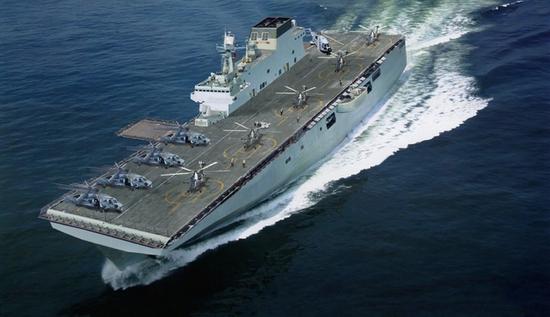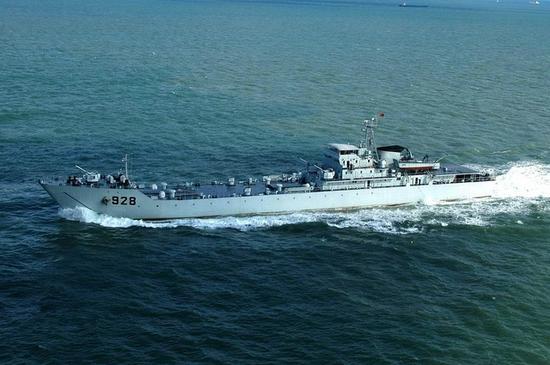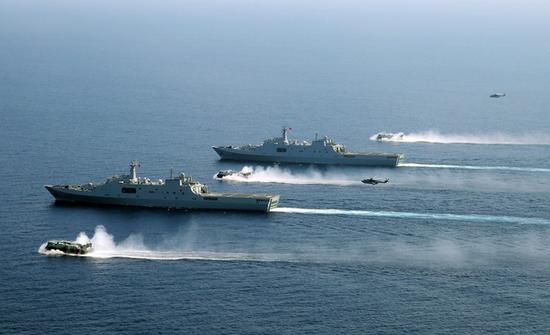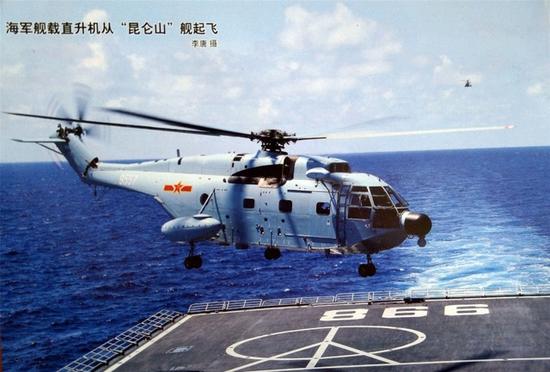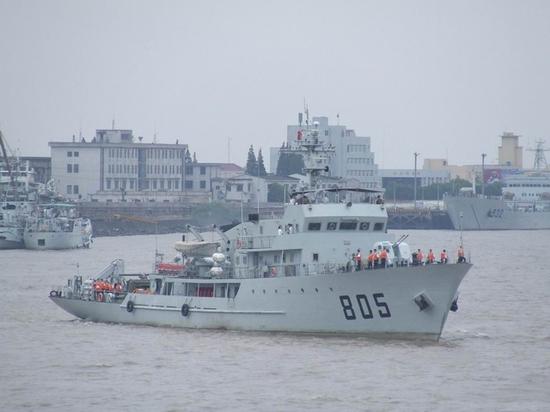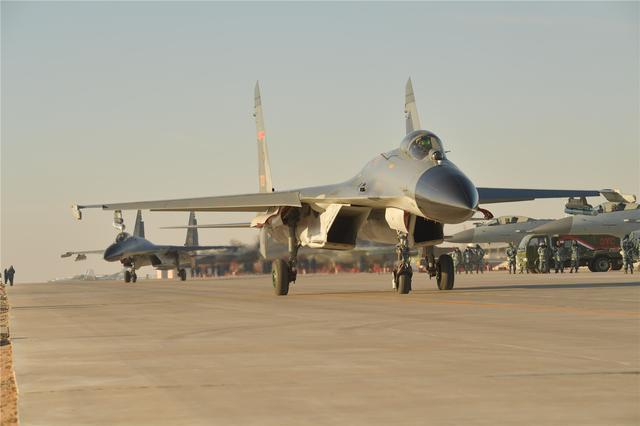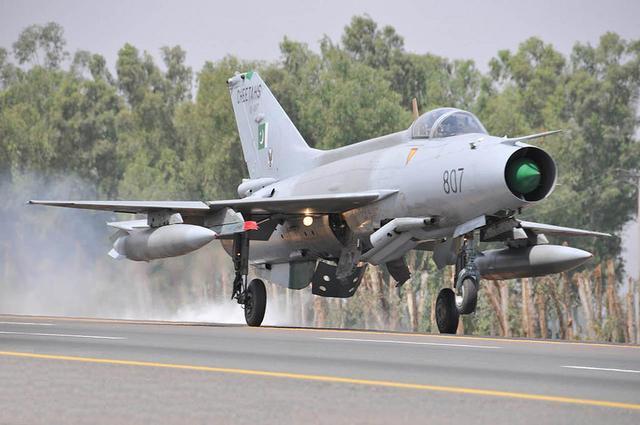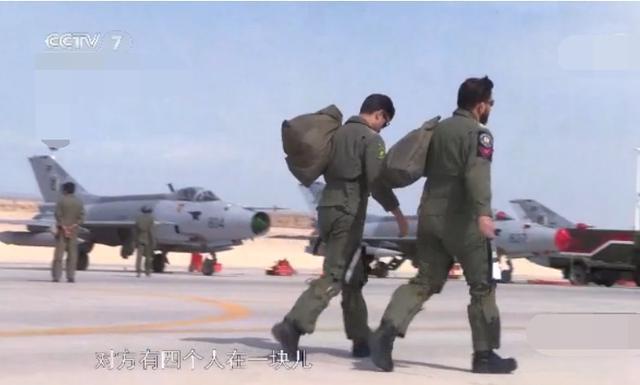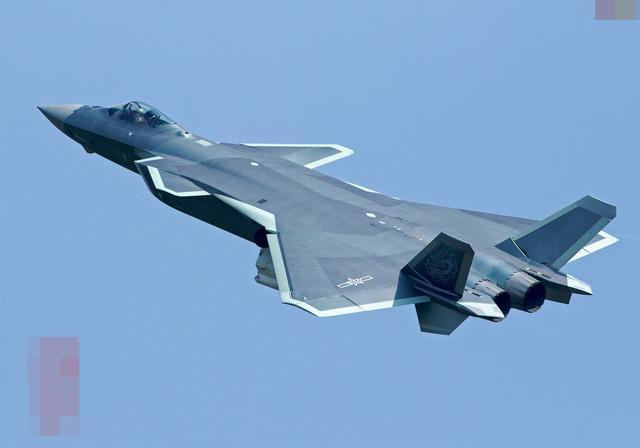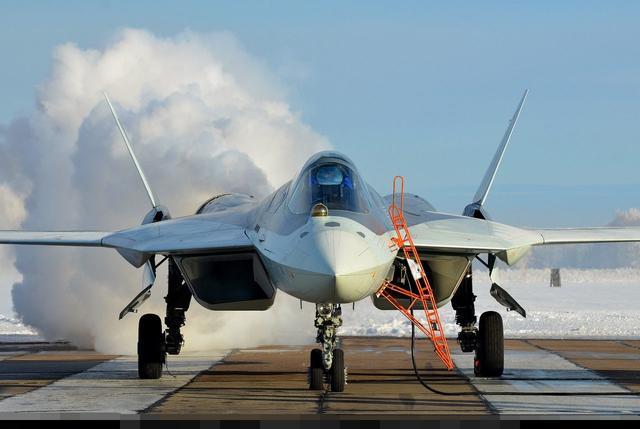China’s Air Force — 1,700 Combat Aircraft Ready for War
Beijing's impressive aerial fleet grew quickly

WIB AIR October 30, 2017 Sebastien Roblin
China39
The People’s Liberation Army Air Force of China and its sister branch, the PLA Naval Air Force, operate a huge fleet of around 1,700 combat aircraft — defined here as fighters, bombers and attack planes. This force is exceeded only by the 3,400 active combat aircraft of the U.S. military.
Moreover, China operates a lot of different aircraft types that are not well known in the West.
However, most Chinese military aircraft are inspired by or copied from Russian or American designs, so it’s not too hard to grasp their capabilities if you know their origins.
 Above — Chinese J-7I at the Beijing Military Museum. Max Smith photo via Wikimedia. At top — a Chinese Su-30. Photo via Wikimedia
Above — Chinese J-7I at the Beijing Military Museum. Max Smith photo via Wikimedia. At top — a Chinese Su-30. Photo via Wikimedia
The Soviet-era clones
The Soviet Union and communist China were best buddies during the 1950s, so Moscow transferred plenty of technology including tanks and jet fighters. One of the early Chinese-manufactured types was the J-6, a clone of the supersonic MiG-19, which has a jet intake in the nose.
Though China built thousands of J-6s, all but a few have been retired. However, about 150 of a pointy-nosed ground-attack version, the Nanchang Q-5, remain in service, upgraded to employ precision-guided munitions.
Sino-Soviet friendship ended in an ugly breakup around 1960. But in 1962, the Soviets offered China a dozen hot new MiG-21 fighters as part of a peace overture. Beijing rejected the overture but kept the fighters, which were reverse-engineered into the sturdier — but heavier — Chengdu J-7. Production began slowly due to the chaos of the Cultural Revolution, but between 1978 and 2013 Chinese factories turned out thousands of the pencil-fuselage jet fighters in dozens of variants.
Nearly 400 J-7s still serve in the PLAAF and PLANAF.
The J-7 is a 1950s-era hot rod in terms of maneuverability and speed — it can keep up with an F-16 at Mach 2 — but it cannot carry much fuel or armament, and it has a weak radar in its tiny nose cone. Still, China has worked to keep the J-7 relevant. The J-7G introduced in 2004 includes an Israeli doppler radar (detection range: 37 miles) and improved missiles for beyond-visual range capabilities, as well as a digital “glass cockpit.”
These aircraft would struggle against modern fourth-generation fighters that can detect and engage adversaries at much greater ranges, though hypothetically mass formations could attempt to overwhelm defenders with swarm attacks. Still, the J-7s allow China to maintain a larger force of trained pilots and support personnel until new designs come into service.
 An H-6 bomber. Photo via Wikimedia
An H-6 bomber. Photo via Wikimedia
China’s B-52
Another Soviet-era clone is the Xi’an H-6, a twin-engine strategic bomber based on the early-1950s era Tu-16 Badger.
Though less capable than the U.S. B-52 or Russian Tu-95 Bear bombers, the air-refuelable H-6K remains relevant because it could lug heavy long-range cruise-missiles hit naval or ground targets as far as 4,000 miles from China without entering the range of air defenses.
The H-6 was originally tasked with dropping nuclear weapons, but the PLAAF no longer seems interested in this role. Xi’an is reportedly developing a new H-20 strategic bomber, though there’s little information available so far.
 A Chinese J-10. Photo via Wikimedia
A Chinese J-10. Photo via Wikimedia
Domestic innovations
In the mid-1960s, China began working on genuinely home-designed combat jets, leading to the Shenyang J-8 debuting in 1979. A large twin-turbojet supersonic interceptor that could attain Mach 2.2 and resembled a cross between the MiG-21 and the larger Su-15, the J-8 lacked modern avionics and maneuverability.
However, the succeeding J-8II variant (about 150 currently serving) improved on the former with an Israeli radar in a new pointy-nose cone, making it a fast but heavy weapons platform a bit like the F-4 Phantom. Around 150 are still operational.
The 200-plus Xi’an JH-7 Flying Leopards, which entered service in 1992, are beefy two-seat naval-attack fighter-bombers that can lug up to 20,000 pounds of missiles and have a top speed of Mach 1.75. Though they wouldn’t want to get in a dogfight with opposing contemporary fighters, they may not have to if they can capitalize on long-range anti-ship missiles.
The Chengdu J-10 Vigorous Dragon, by contrast, is basically China’s F-16 Fighting Falcon, a highly maneuverable, lightweight multi-role fighter leaning on fly-by-wire avionics to compensate for its aerodynamically unstable airframe.
Currently dependent on Russian AL-31F turbofans, and coming several decades after the F-16 debuted, the J-10 seems may not seem earthshaking, but the J-10B model comes out of the box with 21st-century avionics such as advanced infrared search-and-track systems and a cutting-edge Active Electronically Scanned Array (AESA) radar, which cannot be said for all F-16 types.
However, the fleet of 250 J-10s has suffered several deadly accidents possibly related to difficulties in the fly-by-wire system.
 A Chinese J-11 photographed from a U.S. Navy P-8A Poseidon. U.S. Navy photo
A Chinese J-11 photographed from a U.S. Navy P-8A Poseidon. U.S. Navy photo
The Flanker comes to China — and stays there
After the dissolution of the Soviet Union, a Russia starved for cash and no longer concerned about ideological disputes was happy to oblige when Beijing came knocking at the door asking to buy then state-of-the-art Sukhoi Su-27 fighters, a highly maneuverable twin-engine jet comparable to the F-15 Eagle with excellent range and payload.
This proved a fateful decision: today a sprawling family of aircraft derived from the Su-27 form the core of China’s modern fighter force.
After importing the initial batch of Su-27s, Beijing purchased a license to domestically build their own copy, the — Shenyang J-11 — but to Russia’s dismay, began independently building more advanced models, the J-11B and D.
Moscow felt burned, but still sold 76 modernized ground- and naval-attack variants of the Flanker, the Su-30MKK and Su-30MK2 respectively, which parallel the F-15E Strike Eagle. Chinese designers also churned out their own derivative of the Su-30: the Shenyang J-16 Red Eagle, boasting an AESA radar, and the Shenyang J-15 Flying Shark, a carrier-based fighter based on a Russian Su-33 acquired from Ukraine.
Around 20 now serve on China’s Type 001 aircraft carrier Liaoning. There’s even the J-16D, a jamming pod-equipped electronic-warfare fighter styled after the U.S. Navy’s EA-18 Growler.
The Chinese Sukhoi derivatives are theoretically on par with the fourth-generation fighters like the F-15 and F-16. However, they are saddled with domestic WS-10 turbofan engines, which have had terrible maintenance problems and difficulty producing enough thrust.
Jet-engine tech remains the chief limitation of Chinese combat aircraft today. Indeed, in 2016 China purchased 24 Su-35s, the most sophisticated and maneuverable variant of the Flanker so far — likely to obtain their AL-41F turbofans engines.
 Chinese J-20s in 2016. Alert5 photo via Wikimedia
Chinese J-20s in 2016. Alert5 photo via Wikimedia
Stealth fighters
In a remarkably short timeframe, China developed two distinct stealth fighter designs. Twenty Chengdu J-20s entered PLAAF service in 2017. Unlike the F-22 Raptor, designed to be the ultimate air superiority fighter, or the single-engine multi-role F-35 Lightning, the J-20 is a huge twin-engine beast optimized for speed, range and heavy weapons loads at the expense of maneuverability.
The J-20 might be suitable for surprise raids on land or sea targets — though its larger rear-aspect radar cross section could be problematic — or to sneak past enemy fighters to take out vulnerable support tankers or AWACs radar planes. Special-mission stealth fighters make sense for a country that is only just getting into the business of operating such technically demanding aircraft.
Meanwhile, the smaller, privately developed Shenyang J-31 Gyrfalcon (or FC-31) is basically a twin-engine remodeling of the F-35 Lightning — quite possibly using schematics hacked off Lockheed computers. Chinese designers may have developed an aerodynamically superior airframe by ditching elements supporting vertical-takeoff-or-landing engines.
However, the J-31 probably won’t boast the fancy sensors and data fusion capabilities of the Lightning.
Currently, the J-31 appears intended for service on upcoming Type 002 aircraft carriers, and for export as a cut-price F-35 alternative. However, while there are flying Gyrfalcon prototypes with Russian engines, the type may only begin production when sufficiently reliable Chinese WS-13 turbofans are perfected.
 Military parade over Beijing in 2015. Kremlin photo
Military parade over Beijing in 2015. Kremlin photo
Toward the future
Roughly 33 percent of the PLAAF and PLANAF’s combat aircraft are old second-generation fighters of limited combat value against peer opponents, save perhaps in swarming attacks. Another 28 percent include strategic bombers and more capable but dated third-generation designs.
Finally, 38 percent are fourth-generation fighters that can theoretically hold their own against peers like the F-15 and F-16.
Stealth fighters account for one percent.
However, the technical capabilities of aircraft are just half the story; at least as important are training, organizational doctrine and supporting assets ranging from satellite recon to air-refueling tankers, ground-based radars and airborne command posts.
For example, China has the intel resources, aircraft and missiles to hunt aircraft carriers. However, the doctrine and experience to link these elements together to form a kill chain is no simple matter. A 2016 Rand report alleges Chinese aviation units are scrambling to reverse a lack of training under realistic conditions and develop experience in joint operations with ground and naval forces.
At any rate, Beijing seems in no rush to replace all its older jets with new ones. Major new acquisitions may wait until the Chinese aviation industry has smoothed out the kinks in its fourth-generation and stealth aircraft.
Beijing's impressive aerial fleet grew quickly

WIB AIR October 30, 2017 Sebastien Roblin
China39
The People’s Liberation Army Air Force of China and its sister branch, the PLA Naval Air Force, operate a huge fleet of around 1,700 combat aircraft — defined here as fighters, bombers and attack planes. This force is exceeded only by the 3,400 active combat aircraft of the U.S. military.
Moreover, China operates a lot of different aircraft types that are not well known in the West.
However, most Chinese military aircraft are inspired by or copied from Russian or American designs, so it’s not too hard to grasp their capabilities if you know their origins.
 Above — Chinese J-7I at the Beijing Military Museum. Max Smith photo via Wikimedia. At top — a Chinese Su-30. Photo via Wikimedia
Above — Chinese J-7I at the Beijing Military Museum. Max Smith photo via Wikimedia. At top — a Chinese Su-30. Photo via WikimediaThe Soviet-era clones
The Soviet Union and communist China were best buddies during the 1950s, so Moscow transferred plenty of technology including tanks and jet fighters. One of the early Chinese-manufactured types was the J-6, a clone of the supersonic MiG-19, which has a jet intake in the nose.
Though China built thousands of J-6s, all but a few have been retired. However, about 150 of a pointy-nosed ground-attack version, the Nanchang Q-5, remain in service, upgraded to employ precision-guided munitions.
Sino-Soviet friendship ended in an ugly breakup around 1960. But in 1962, the Soviets offered China a dozen hot new MiG-21 fighters as part of a peace overture. Beijing rejected the overture but kept the fighters, which were reverse-engineered into the sturdier — but heavier — Chengdu J-7. Production began slowly due to the chaos of the Cultural Revolution, but between 1978 and 2013 Chinese factories turned out thousands of the pencil-fuselage jet fighters in dozens of variants.
Nearly 400 J-7s still serve in the PLAAF and PLANAF.
The J-7 is a 1950s-era hot rod in terms of maneuverability and speed — it can keep up with an F-16 at Mach 2 — but it cannot carry much fuel or armament, and it has a weak radar in its tiny nose cone. Still, China has worked to keep the J-7 relevant. The J-7G introduced in 2004 includes an Israeli doppler radar (detection range: 37 miles) and improved missiles for beyond-visual range capabilities, as well as a digital “glass cockpit.”
These aircraft would struggle against modern fourth-generation fighters that can detect and engage adversaries at much greater ranges, though hypothetically mass formations could attempt to overwhelm defenders with swarm attacks. Still, the J-7s allow China to maintain a larger force of trained pilots and support personnel until new designs come into service.
 An H-6 bomber. Photo via Wikimedia
An H-6 bomber. Photo via WikimediaChina’s B-52
Another Soviet-era clone is the Xi’an H-6, a twin-engine strategic bomber based on the early-1950s era Tu-16 Badger.
Though less capable than the U.S. B-52 or Russian Tu-95 Bear bombers, the air-refuelable H-6K remains relevant because it could lug heavy long-range cruise-missiles hit naval or ground targets as far as 4,000 miles from China without entering the range of air defenses.
The H-6 was originally tasked with dropping nuclear weapons, but the PLAAF no longer seems interested in this role. Xi’an is reportedly developing a new H-20 strategic bomber, though there’s little information available so far.
 A Chinese J-10. Photo via Wikimedia
A Chinese J-10. Photo via WikimediaDomestic innovations
In the mid-1960s, China began working on genuinely home-designed combat jets, leading to the Shenyang J-8 debuting in 1979. A large twin-turbojet supersonic interceptor that could attain Mach 2.2 and resembled a cross between the MiG-21 and the larger Su-15, the J-8 lacked modern avionics and maneuverability.
However, the succeeding J-8II variant (about 150 currently serving) improved on the former with an Israeli radar in a new pointy-nose cone, making it a fast but heavy weapons platform a bit like the F-4 Phantom. Around 150 are still operational.
The 200-plus Xi’an JH-7 Flying Leopards, which entered service in 1992, are beefy two-seat naval-attack fighter-bombers that can lug up to 20,000 pounds of missiles and have a top speed of Mach 1.75. Though they wouldn’t want to get in a dogfight with opposing contemporary fighters, they may not have to if they can capitalize on long-range anti-ship missiles.
The Chengdu J-10 Vigorous Dragon, by contrast, is basically China’s F-16 Fighting Falcon, a highly maneuverable, lightweight multi-role fighter leaning on fly-by-wire avionics to compensate for its aerodynamically unstable airframe.
Currently dependent on Russian AL-31F turbofans, and coming several decades after the F-16 debuted, the J-10 seems may not seem earthshaking, but the J-10B model comes out of the box with 21st-century avionics such as advanced infrared search-and-track systems and a cutting-edge Active Electronically Scanned Array (AESA) radar, which cannot be said for all F-16 types.
However, the fleet of 250 J-10s has suffered several deadly accidents possibly related to difficulties in the fly-by-wire system.
 A Chinese J-11 photographed from a U.S. Navy P-8A Poseidon. U.S. Navy photo
A Chinese J-11 photographed from a U.S. Navy P-8A Poseidon. U.S. Navy photoThe Flanker comes to China — and stays there
After the dissolution of the Soviet Union, a Russia starved for cash and no longer concerned about ideological disputes was happy to oblige when Beijing came knocking at the door asking to buy then state-of-the-art Sukhoi Su-27 fighters, a highly maneuverable twin-engine jet comparable to the F-15 Eagle with excellent range and payload.
This proved a fateful decision: today a sprawling family of aircraft derived from the Su-27 form the core of China’s modern fighter force.
After importing the initial batch of Su-27s, Beijing purchased a license to domestically build their own copy, the — Shenyang J-11 — but to Russia’s dismay, began independently building more advanced models, the J-11B and D.
Moscow felt burned, but still sold 76 modernized ground- and naval-attack variants of the Flanker, the Su-30MKK and Su-30MK2 respectively, which parallel the F-15E Strike Eagle. Chinese designers also churned out their own derivative of the Su-30: the Shenyang J-16 Red Eagle, boasting an AESA radar, and the Shenyang J-15 Flying Shark, a carrier-based fighter based on a Russian Su-33 acquired from Ukraine.
Around 20 now serve on China’s Type 001 aircraft carrier Liaoning. There’s even the J-16D, a jamming pod-equipped electronic-warfare fighter styled after the U.S. Navy’s EA-18 Growler.
The Chinese Sukhoi derivatives are theoretically on par with the fourth-generation fighters like the F-15 and F-16. However, they are saddled with domestic WS-10 turbofan engines, which have had terrible maintenance problems and difficulty producing enough thrust.
Jet-engine tech remains the chief limitation of Chinese combat aircraft today. Indeed, in 2016 China purchased 24 Su-35s, the most sophisticated and maneuverable variant of the Flanker so far — likely to obtain their AL-41F turbofans engines.
 Chinese J-20s in 2016. Alert5 photo via Wikimedia
Chinese J-20s in 2016. Alert5 photo via WikimediaStealth fighters
In a remarkably short timeframe, China developed two distinct stealth fighter designs. Twenty Chengdu J-20s entered PLAAF service in 2017. Unlike the F-22 Raptor, designed to be the ultimate air superiority fighter, or the single-engine multi-role F-35 Lightning, the J-20 is a huge twin-engine beast optimized for speed, range and heavy weapons loads at the expense of maneuverability.
The J-20 might be suitable for surprise raids on land or sea targets — though its larger rear-aspect radar cross section could be problematic — or to sneak past enemy fighters to take out vulnerable support tankers or AWACs radar planes. Special-mission stealth fighters make sense for a country that is only just getting into the business of operating such technically demanding aircraft.
Meanwhile, the smaller, privately developed Shenyang J-31 Gyrfalcon (or FC-31) is basically a twin-engine remodeling of the F-35 Lightning — quite possibly using schematics hacked off Lockheed computers. Chinese designers may have developed an aerodynamically superior airframe by ditching elements supporting vertical-takeoff-or-landing engines.
However, the J-31 probably won’t boast the fancy sensors and data fusion capabilities of the Lightning.
Currently, the J-31 appears intended for service on upcoming Type 002 aircraft carriers, and for export as a cut-price F-35 alternative. However, while there are flying Gyrfalcon prototypes with Russian engines, the type may only begin production when sufficiently reliable Chinese WS-13 turbofans are perfected.
 Military parade over Beijing in 2015. Kremlin photo
Military parade over Beijing in 2015. Kremlin photoToward the future
Roughly 33 percent of the PLAAF and PLANAF’s combat aircraft are old second-generation fighters of limited combat value against peer opponents, save perhaps in swarming attacks. Another 28 percent include strategic bombers and more capable but dated third-generation designs.
Finally, 38 percent are fourth-generation fighters that can theoretically hold their own against peers like the F-15 and F-16.
Stealth fighters account for one percent.
However, the technical capabilities of aircraft are just half the story; at least as important are training, organizational doctrine and supporting assets ranging from satellite recon to air-refueling tankers, ground-based radars and airborne command posts.
For example, China has the intel resources, aircraft and missiles to hunt aircraft carriers. However, the doctrine and experience to link these elements together to form a kill chain is no simple matter. A 2016 Rand report alleges Chinese aviation units are scrambling to reverse a lack of training under realistic conditions and develop experience in joint operations with ground and naval forces.
At any rate, Beijing seems in no rush to replace all its older jets with new ones. Major new acquisitions may wait until the Chinese aviation industry has smoothed out the kinks in its fourth-generation and stealth aircraft.





